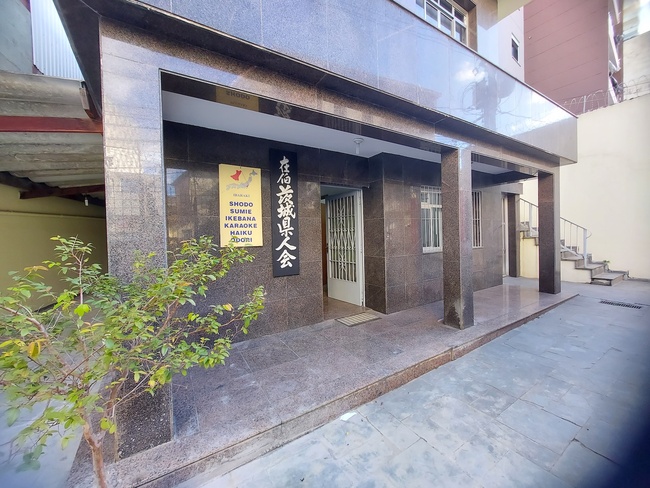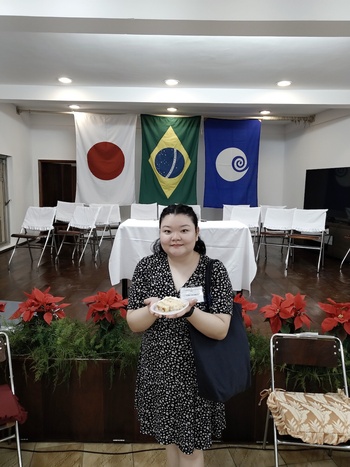Part One: Childhood
My name is Janina Tiemi Enomoto, and I am a third-generation Japanese descendant on both sides. I was born in a conurbation area of the city of São Paulo. My family is from the greater São Paulo region and I attended a Brazilian school where the only Japanese descendants were my cousins.
When I was little, my grandparents would go to the Liberdade area of São Paulo to buy food such as tofu, miso and hondashi, which they used to prepare lunch or dinner. I remember eating onigiri and omelets with a little sugar prepared by my bachan many times. My grandparents also frequently visited the shops in Liberdade, the Buddhist temple in São Paulo and the Ibaraki Kenjinkai, which is what I will describe today.
My parents and grandparents always went to the Kenjinkai, usually on weekends. Since I was little, I don’t remember exactly which events were celebrated, but the sign at the entrance indicates that there were ikebana workshops, karaoke, shodo, bon odori, and other activities aimed at the elderly. The Associação Centro Social Ibaraki do Brasil was created in 1961. Its headquarters are in São Paulo, in the Aclimação region, with two regional branches in Guatapará and Mogi das Cruzes. My great-uncle, Hideo Enomoto, was one of the first presidents. However, I remember my grandfather, Minoru Enomoto, more, who, together with my father, Nelson Takeshi Enomoto, would take me there. Perhaps they were festivities like bonenkai, shinnenkai, or a weekend of shodo and sumi-e activities.
Going to the Kenjinkai was a family event. My friends went to church or clubs, and there was a time when I had trouble understanding that Japanese was spoken there. Over time, I realized that my grandfather spoke Japanese to me to teach me. When I was little, there weren’t many children to play with me in the big hall. Eventually, I would sit next to my family or help carry tea, soda, and food from the kitchen to the main hall, where the women would usually prepare the food.
Part Two: Adult Life
When I was seven years old, my family moved to another city and we stopped attending the association. I started studying Japanese at Nippo in Campinas and, years later, I entered the University of Campinas. Even so, I heard about scholarships for studying in Japan and decided to study Japanese as an extra subject. My father was a scholarship holder of the Kempi program and said that in his time it was easy to go to Japan, but I didn't know if there were still scholarships available.
In 2019, I received the MEXT Japanese Language and Culture Scholarship for Descendants and studied at Hokkaido Kyōiku Daigaku. Unfortunately, in 2020, the COVID-19 pandemic affected the world and, consequently, my plans to travel to the city of origin of my ancestors. Thus, I spent almost the entire exchange in Hokkaido.
When I returned to Brazil, I decided to reconnect and give back what I learned in Japan, both in academics and through volunteer work. I contacted the Ibaraki Kenjinkai and joined ABMON (the Association of Japanese Government Scholars). I participated in the Japan Festival, helping to make dorayaki with kuri.In 2022, the Ibaraki Kenjinkai celebrated its 60th anniversary. The governor of Ibaraki and his entourage came to Brazil for the celebration. It was a remarkable event, as it had been a long time since I had seen the Kenjinkai so full. Both the lower and upper floors of the building were packed with people. However, unlike when I was a child, there were few children running around the lobby, and most of the attendees were elderly people receiving awards.
From 2022 to 2024, I was the second secretary of the Ibaraki Kenjinkai and organized various activities for the youth group, such as studying for the Japanese language proficiency test and creating the association's Instagram.
Since I still lived far away, my contributions were mainly online. In 2023-2024, thanks to the recommendation of then-president Izumi Honda, I received the Kempi-Trainee scholarship from the Nikkei leadership training program, aimed at people of Latin American descent (Brazil and Argentina). One of the questions she asked me was whether I would live in São Paulo again in the future. At the time, my answer was uncertain. However, I continued to actively promote the association's activities on social media. During this experience, I was able to delve deeper into academic research on the sociology of education at the University of Tsukuba.
Unlike my first time in Japan, this time I was able to visit the Ibaraki region, where my great-grandfather was born. I also took the opportunity to visit Tochigi and Niigata, the places where my other grandparents were from. These were brief visits, but they helped me better understand the difficulties of farming in cold climates and the reality of large families at the time. Back in Brazil, I continue to face difficulties in participating in the Kenjinkai activities in person, since I still live far away. In addition, I feel a distance from the young people in the association due to the age difference and the fact that I am no longer a member of the board. Currently, the most popular activities are shodo, sumiê and table tennis.
© 2025 Janina Tiemi Enomoto










